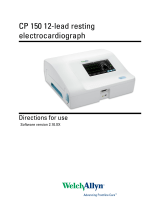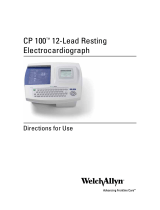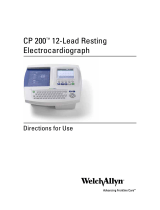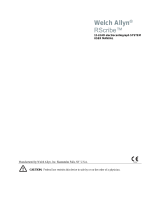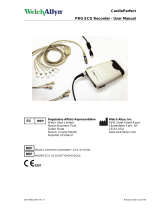Page is loading ...

CP 50™ and CP 50 Plus™ 12-lead resting
electrocardiograph
Quick reference guide
Powering the electrocardiograph
The electrocardiograph runs on AC or battery power. Plug the electrocardiograph into AC
power as often as possible so that the built-in charger can keep the battery charged.
Regardless of the battery condition, you can use the electrocardiograph whenever it is
plugged in.
WARNING When you use AC power, always plug the electrocardiograph
into a hospital-grade outlet to avoid the risk of shock.
WARNING If the integrity of the building’s safety ground is in doubt,
operate this device on battery power to avoid the risk of shock.
To power up or power down
Press .
1

Attaching the leads to the patient
Proper lead attachment is important for a successful ECG. The most common ECG
problems are caused by poor electrode contact and loose leads. Follow your local
procedures for attaching the leads to the patient. Here are some common guidelines.
To attach the leads to the patient
1. Prepare the patient.
• Describe the procedure. Explain the importance of holding still during the test.
(Movement can create artifact.)
• Verify that the patient is comfortable, warm, and relaxed. (Shivering can create
artifact.)
• Put the patient in a reclining position with the head slightly higher than the heart
and legs (the semi-Fowler’s position).
2. Select the electrode locations. (See the “Electrode locations” chart.)
• Look for flat areas.
• Avoid fatty areas, bony areas, and major muscles.
3. Prepare the electrode locations.
• Shave or clip the hair.
• Thoroughly clean the skin, and lightly rub it dry. You may use soap and water,
isopropyl alcohol, or skin preparation pads.
4. Attach the lead wires to the electrodes.
5. Apply the electrodes to the patient.
Electrode examples, left to right: arm clamp (reusable), Welsh cup (reusable), tab
electrode (disposable), monitoring electrode (disposable).
•For reusable electrodes: Use electrode paste, gel, or cream to cover an area
the size of each electrode but no larger. Secure the arm and leg clamps. Apply
the Welsh cups (suction electrodes) to the chest.
2 CP 50™ and CP 50 Plus™ 12-lead resting electrocardiograph

•For disposable tab electrodes: Place the electrode tab between the “jaws” of
the connector. Keep the tab flat. Verify that the metal portion of the connector
makes contact with the skin side of the electrode tab.
•For all disposable electrodes: Lightly tug on the connector to ensure that the
lead is securely attached. If the electrode comes off, replace it with a new
electrode. If the connector comes off, reconnect it.
CP 50™ and CP 50 Plus™ 12-lead resting electrocardiograph 3

Electrode locations
AHA IEC Location
AV1
(red) C1
(red) Fourth intercostal space at the right sternal border.
BV2
(yellow) C2
(yellow) Fourth intercostal space at the left sternal border.
CV3
(green) C3
(green) Midway between V2 and V4.
DV4
(blue) C4
(brown) Fifth intercostal space to the left of the midclavicular line.
EV5
(orange) C5
(black) Anterior axillary line at the same horizontal level as V4.
FV6
(purple C6
(purple) Mid-axillary line at the same horizontal level as V4 and V5.
GLA
(black) L
(yellow) Just above the left wrist on the inside of the arm.
HLL
(red) R
(green) Just above the left ankle.
4 CP 50™ and CP 50 Plus™ 12-lead resting electrocardiograph

AHA IEC Location
IRL
(green) N
(black) Just above the right ankle.
JRA
(white) R
(red) Just above the right wrist on the inside of the arm.
CP 50™ and CP 50 Plus™ 12-lead resting electrocardiograph 5

About the test types
Auto ECG A report typically showing a 10-second acquisition of 12 leads of ECG information combined with
patient data, measurements, and optional interpretation. Auto ECGs can be saved to the
electrocardiograph’s test directory or to a USB mass-storage device. In CP 50 Plus models, auto ECGs
can also be sent to a Welch Allyn CardioPerfect workstation.
Auto ECG report example
Stat ECG An auto ECG that starts instantly without waiting for you to enter patient data or adjust the
waveforms.
Rhythm ECG A continuous, real-time printout of rhythm strips with a user-defined lead configuration. Rhythm ECGs
are printouts only. They cannot be saved.
Rhythm ECG report example
6 CP 50™ and CP 50 Plus™ 12-lead resting electrocardiograph

Performing an ECG test
1. Attach the leads to the patient. Any flashing dots on the lead-status screen indicate
unattached or poorly attached leads.
When all leads have been attached for several seconds, the ECG preview screen
appears.
Leads button
Gain button (size)
Speed button
Filters button
2. If an Artifact message appears, minimize the artifact, as described under
Troubleshooting. You might need to ensure that the patient is comfortably warm,
reprepare the patient’s skin, use fresh electrodes, or minimize patient motion.
3. (Optional) Adjust the waveforms, using the buttons to cycle through the options:
• leads displayed
• gain (size)
• speed
• filters
4. Perform the desired type of test: stat ECG, auto ECG, or rhythm ECG.
For auto ECGs, you can enter patient data automatically if it is available.
CP 50™ and CP 50 Plus™ 12-lead resting electrocardiograph 7

• The Search button gives you access to patient data in the test directory or in
a connected database (CardioPerfect workstation or EMR).
• The Worklist button (CP 50 Plus only) gives you access to patient data in the
worklist.
5. If a Waiting for 10 (or 20) seconds of quality data message appears, at least 10 or
20 seconds of ECG data have been collected with excessive artifact. Time
requirements in the message may vary, based upon selected print format. Minimize
the artifact, as described under Troubleshooting. Then wait for the test to print. If
necessary, you can override the wait time and print the available data immediately,
but the result might be an incomplete or poor-quality test.
6. After the test prints, select the desired option: Reprint, Save, Retest, or Assign
(Any tests that you save to a USB mass-storage device can be retrieved only from a
CardioPerfect workstation.)
WARNING To avoid the risk of associating reports with the
wrong patients, make sure that each test identifies the
patient. If any report does not identify the patient, write the
patient identification information on the report immediately
following the ECG test.
8 CP 50™ and CP 50 Plus™ 12-lead resting electrocardiograph

Loading the thermal paper
The electrocardiograph prints on z-fold thermal paper or roll thermal paper.
• Store the paper in a cool, dry, dark place.
• Do not expose it to bright light or UV sources.
• Do not expose it to solvents, adhesives, or cleaning fluids.
• Do not store it with vinyls, plastics, or shrink wraps.
To load z-fold thermal paper
CP 50™ and CP 50 Plus™ 12-lead resting electrocardiograph 9

To load a roll of thermal paper
10 CP 50™ and CP 50 Plus™ 12-lead resting electrocardiograph

About the menu
The menu provides access to the saved patient tests, the settings, and the service
functions. From either of the main screens, you can reach the menu by touching the
menu button.
CP 50™ and CP 50 Plus™ 12-lead resting electrocardiograph 11

12 CP 50™ and CP 50 Plus™ 12-lead resting electrocardiograph

Troubleshooting
Lead-quality problems
“Artifact” message on the screen
Artifact is signal distortion that makes it difficult to accurately discern the waveform
morphology.
Causes
•The patient was moving.
• The patient was shivering.
• There is electrical interference.
Actions
See actions for wandering baseline, muscle tremor, and AC interference.
Wandering baseline
Wandering baseline is an upward and downward fluctuation of the waveforms.
Causes
•Electrodes are dirty, corroded, loose, or positioned on bony areas.
• The electrode gel is insufficient or dried.
• The patient has oily skin or used body lotions.
• Rising and falling of chest during rapid or apprehensive breathing.
Actions
•Clean the patient’s skin with alcohol or acetone.
• Reposition or replace the electrodes.
• Verify that the patient is comfortable, warm, and relaxed.
• If wandering baseline persists, turn the baseline filter on.
13

Muscle tremor
Causes
• The patient is uncomfortable, tense, nervous.
• The patient is cold and shivering.
• The exam bed is too narrow or short to comfortably support arms and legs.
• The arm or leg electrode straps are too tight.
Actions
• Verify that the patient is comfortable, warm, and relaxed.
• Check all electrode contacts.
• If interference persists, turn the muscle-tremor filter on. If interference still persists,
the problem is probably electrical in nature. See the suggestions for reducing AC
interference (in a related troubleshooting tip).
AC interference
AC interference superimposes even-peaked, regular voltage on the waveforms.
Causes
•The patient or technician was touching an electrode during recording.
• The patient was touching a metal part of an exam table or bed.
• A lead wire, patient cable, or power cord are broken.
• Electrical devices in the immediate area, or lighting, or wiring concealed in walls or
floors are interfering.
• An electrical outlet is improperly grounded.
• The AC filter is turned off or set incorrectly.
Actions
•Verify that the patient is not touching any metal.
• Verify that the AC power cable is not touching the patient cable.
• Verify that the proper AC filter is selected.
• If interference persists, unplug the electrocardiograph from AC power and run it on
the battery. If this solves the problem, you’ll know that the noise was introduced
through the power line.
• If interference still persists, the noise may be caused by other equipment in the
room or by poorly grounded power lines. Try moving to another room.
14 Troubleshooting

Lead alert or square wave
A dot might be flashing on the lead-status screen. Or one or more leads might appear as
a square wave.
Causes
• Electrode contact might be poor.
• A lead might be loose.
• A lead might be defective.
Actions
• Replace the electrode.
• Verify that the patient’s skin has been properly prepared.
• Verify that electrodes have been properly stored and handled.
• Replace the patient cable.
Troubleshooting 15

System problems
The electrocardiograph won't turn on when it is plugged in
Causes
• The AC power connection is faulty.
• An AC fuse is blown.
• There is no AC power.
Actions
• Check the AC power source.
• Check the AC fuses.
The electrocardiograph won't turn on when it is unplugged
Causes
• The battery is disconnected or incorrectly connected.
• The battery is low, not charging, depleted, or bad.
Actions
•Check the battery connections.
• Recharge the battery.
• Replace the battery.
The electrocardiograph shuts down during printing
Causes
•The battery is low or bad.
Actions
•Recharge the battery.
• Replace the battery.
The electrocardiograph prints fewer than 10 reports on a full battery
charge
Causes
•The battery is degraded.
Actions
•Replace the battery.
16 Troubleshooting

The electrocardiograph does not respond when you press buttons or
touch the screen
Causes
• The electrocardiograph is frozen.
Actions
• Reset the electrocardiograph by pressing and holding the power button for at least
six seconds until the screen goes blank. Press the power button again. The
electrocardiograph goes through some diagnostic tests that cause it to take longer
than usual to power up.
Note For more troubleshooting guidelines, see the service manual.
CAUTION The service manual is for use only by qualified service
personnel who understand technical English.
Troubleshooting 17



Consult operating instructions/directions for use (DFU).
A copy of the DFU is available on this website.
A printed copy of the DFU can be ordered from Welch Allyn for delivery within 7 calendar
days.
For information about any Welch Allyn product, contact Welch Allyn Technical support:
www.welchallyn.com/about/company/locations.htm.
Mat. 105781 Ver. G
© 2014 Welch Allyn, Inc
/

